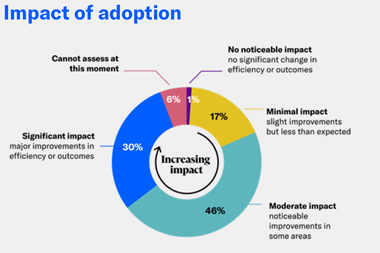More and more risk managers of multinational corporations are asking themselves - or are being asked by their boards - whether their directors' and officers' liability (D&O) insurance programme is truly global in nature. Do the terms and conditions account for coverage and wording differences in jurisdictions outside the area where it was bought? More often than not, the answer is no.
The main reason for this a failure to view the D&O policy wording in a global context. Instead, the policy provisions reflect the standard practice of the country where it was purchased. For example, a global D&O insurance programme placed in the UK is typically not reviewed against the standard D&O insurance wording for global programmes bought in the US, and vice versa. This is just one example. The same applies in any number of jurisdictions.
The danger is that usually any programme bought in one particular jurisdiction in the world, such as the UK, will have deficiencies in it vis-à-vis a programme that could have been purchased elsewhere. For example, comparing the standard UK D&O policy wording with its US equivalent reveals significant deficiencies . Likewise, the US wording has deficiencies when compared to the UK.
Importantly, the same type of analysis can be done in the reverse, identifying deficiencies in standard US D&O policy wording vis-à-vis standard UK policy wording. The most notable deficiency is that the US policy 'insured vs insured' exclusion is much broader than the wording used for the same exclusion in D&O policies available in the UK. This is just one example; there are others.
Addressing differences
The message is that any standard D&O programme is likely to have deficiencies compared to policy wording used in other jurisdictions. And, unless such deficiencies are addressed, there is a risk that a claim brought in a jurisdiction other than that in which the global programme is placed may not be covered, even though it would have been covered by a programme placed in the foreign jurisdiction.
The fact that D&O policy wording differs on a global basis has not been lost on some of the world's leading underwriters of D&O insurance. AIG, for example, identified this issue a couple of years ago, and last year launched a new type of D&O insurance programme to address it.
AIG's approach is to issue locally admitted D&O insurance policies in those countries where the corporate parent has subsidiaries and affiliates that need to be insured. Because they are written on admitted paper, the theory is that they take into account the policy wording characteristics associated with the country in which they are written. AIG also issues a master global D&O insurance policy, which has a 'follow form' and difference-in-conditions/ difference-in-limits endorsement. If a locally admitted policy in the programme responds to a claim but does not have high enough limits to cover it in full, then the master global D&O policy provides 'follow form' excess coverage.
Whether AIG's approach solves the problem remains to be seen. For it to do so, each locally admitted policy must have very favourable wording for the country in which the policy is issued.
An alternative method of trying to address D&O policy wording differences on a global basis involves gathering exemplary and favourable D&O policy wordings from key jurisdictions where cover is required. Reviewing such wordings identifies any provisions that are unique or more favourable than their counterparts in the global programme's existing policy wording. These provisions can then be incorporated into the programme's wording.
For example, some enhanced global D&O programmes placed in the US provide that the 'insured vs insured' exclusion does not apply to claims brought in certain jurisdictions in Europe. Such a provision recognises and addresses a key policy wording difference between US-based D&O programmes and certain Europe-based ones.
A third method, and perhaps the most aggressive, is to combine both of the above approaches. This is a kind of belt and braces approach, with the goal of not only making sure that nothing falls through cracks, but also trying to obtain in the global programme the 'best of the best' of what D&O policies around the world have to offer.
--
Michael Rossi is president of Insurance Law Group, Inc. Telephone 001 818-649-7654,
Email: mrossi@inslawgroup.com
www.inslawgroup.com
Guide to Developing a Global D&O Insurance Programme
These are practical tips on how to develop a D&O insurance programme that takes into account policy wording differences between one jurisdiction and the next
The following seem elementary but it is amazing how many times some or all of these fundamental steps are not followed. The results range from the unfortunate to the truly disastrous.
Step 1: Brainstorming session with the broker
Begin the process by brainstorming with your insurance broker. There should be a frank discussion of the issues,of viable solutions, and of the pros and cons of the solutions. You should agree upon what solution will be implemented, the steps to be taken to implement that solution, and milestones to ensure that the solution will be implemented on time.
Step 2: Comparing quoted forms to what is available in the market
The form to be used for the programme must be reviewed in detail, against other policy forms in the same jurisdiction, and other policy forms in foreign jurisdictions that are important for your company. Identify and discuss key deficiencies.
Step 3: Drafting list of requested changes to policy form
Once the deficiencies in the form are identified, a list of requested changes should be drafted. Give support for each request (eg if another policy form in the same jurisdiction addresses the issue as requested, or if a policy form in a foreign jurisdiction addresses the issue as requested.
Step 4: Prioritising the requested changes
Before the broker begins negotiating with the insurer, both the risk manager and broker should review the list of changes and prioritise them. For example, category A requests could be deal breakers - issues that simply must be addressed. Category B requests could be important issues - issues that the broker should really try to get addressed. And category C requests could be the 'bargaining chips' - issues that you don't mind giving away in exchange for agreement on a category A or category B request.
Step 5: Negotiating with underwriters
There is more to negotiating policy wording changes with insurers than simply handing them a list of requested changes. In addition to explaining the reasons for the changes, it is important to listen to the underwriter's response. In some cases, a concern raised by an underwriter can be addressed by using an alternative language that both takes account of the underwriter's concerns and gets the policy enhancement that you want. In other cases, an underwriter might not be able to address the issue in the way requested, but can offer an alternative solution that is just as favourable.
Step 6: Documenting agreed changes
There are many ways of documenting what issues underwriters have agreed to address. You can attach the initial request for changes and all written responses from underwriters to the binder to document the changes. Or you can write the changes into a manuscripted policy form, and this can be attached to the binder. Or you can attach to the binder a master list of agreed changes, signed off by both underwriters and insured.
Step 7: Reviewing the policy for accuracy
The policy should always be issued in draft for review by the broker and insured before the insurer actually issues the policy. Virtually all initial drafts of insurance policies have mistakes in them, and it is much easier and more efficient to correct them before the policy is actually issued. Typically, the only way to address mistakes identified after the policy is formally issued is by correction endorsements. These clutter the policy and make it much more difficult to review, understand and apply at claim time.
Follow each step
It's essential to follow all these steps. What good is it to take time to brainstorm issues, negotiate and document changes to the policy form, but not to review the policy for accuracy? And what good is it to negotiate, document and review for accuracy if the broker and risk manager never really brainstormed the issues or analysed the wording to determine where there were deficiencies? The answer in both instances is 'no good'.



















